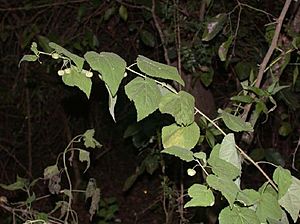Rio Grande ayenia facts for kids
Quick facts for kids Rio Grande ayenia |
|
|---|---|
 |
|
| Conservation status | |
| Scientific classification | |
| Genus: |
Ayenia
|
| Species: |
limitaris
|
| Synonyms | |
|
|
The Rio Grande ayenia (Ayenia limitaris) is a very rare flowering plant. It belongs to the mallow family. People also call it the Texas ayenia or Tamaulipan kidneypetal. This plant grows naturally near the Rio Grande river in both Mexico and the United States.
Today, you can find it in Texas (the far southern part) and in the northern parts of the Mexican states of Coahuila and Tamaulipas. Sadly, this plant has become rare. This is because most of its natural home has been damaged or destroyed. Experts believe there are only about 1,000 plants left in total. It is listed as an endangered species in the United States.
Contents
What Does the Rio Grande Ayenia Look Like?
This plant is a shrub that can grow up to 1.5 meters (about 5 feet) tall. Its leaves grow in an alternating pattern along the stem. The leaves are shaped like a heart and have fuzzy hairs. Their edges are slightly toothed, like tiny saw blades.
The flowers of the Rio Grande ayenia are small. They can be pinkish, greenish, or whitish in color. After the flowers, the plant produces a fruit. This fruit is a prickly capsule. It is divided into five small sections, each holding seeds.
Where Does the Rio Grande Ayenia Live?
The Rio Grande ayenia used to live in subtropical woodlands. These areas were along the riverbanks of the Rio Grande delta. The plant grew in dense thickets within the floodplains. It likely needed the regular floods that happened in these areas.
Today, most of this natural home is gone. Only about 5% of its original habitat remains. This special habitat is called the Texas ebony-anacua plant community.
Why Is Its Home Disappearing?
Many things have caused the Rio Grande ayenia's habitat to shrink.
- Fences and Roads: Areas have been fenced off and cut up by roads.
- Canals and Ditches: New canals and ditches have changed the water flow.
- Farming: Much of the land has been plowed for agriculture.
- Cattle: Large groups of cattle have walked on the land, making the soil hard.
- New Plants: Plants from other places, like Guinea grass, have grown and taken over.
Also, the natural floods that the plant might need are now mostly controlled. This means the plant doesn't get the regular flooding it might need to thrive.
Who Eats the Rio Grande Ayenia?
A type of bug called Ormenis pruinosa is known to feed on the Rio Grande ayenia plant.


